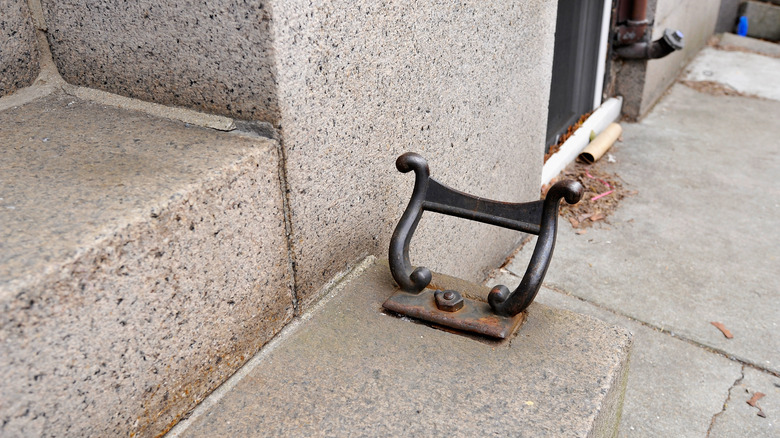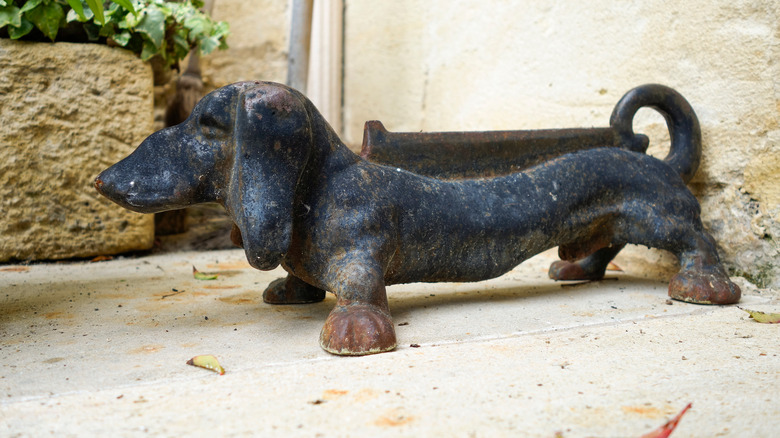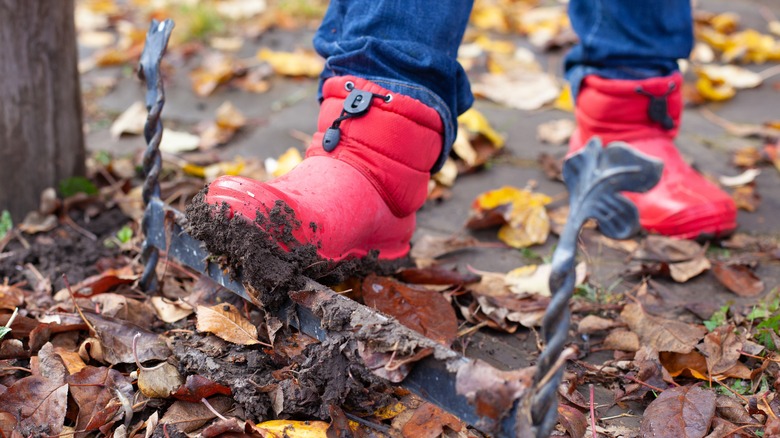What It Means If You See A Cast-Iron Structure On The Front Stoop Of An Old Home
Avoiding trekking mud into the house is an age-old challenge. In the 21st century, houses have a stylish and functional boot room with a spiky doormat for dirt removal. In centuries past, people wiped their shoes on cast iron boot scrapers before walking in the front door. The roads in those days were covered in horse poop, dust, and maybe even sewage; you wouldn't want that staining your hallway rugs. You can still see these boot scrapers (or boot jacks) adorning entranceways in historical city neighborhoods across the U.S. Does this mean you should stop and scrape your boots on them? Once upon a time, certainly. In fact, it was probably expected. Today, it's best to check with the homeowner first — they may be trying to preserve the feature for posterity only.
Cast iron scrapers started to pop up in the posher parts of big cities worldwide (think New York, Paris, and London) through the 17th and 18th centuries, in sync with the rapid urban development of the time. Some feature two short ornate poles with a blunt blade in the center bolted to a sturdy cobblestone — the more popular design in the U.S. Others are attached to a nearby wall and consist of a concave metal half-round frame with a blade across the bottom half. (The former was most popular here.) With both designs, you place the sole of your boot or shoe over the blade and move it back and forth to scrape off all the muck.
Get your own
If you want to install one of these handy yet decorative items outside your home and don't mind buying the item new, you're in luck. Boot scrapers are having a bit of a moment, and interior stores and big box retailers alike are carrying them for affordable prices. At the lower-budget end, Home Depot has a reproduction antique black wrought-iron boot scraper for just $38.46. A simple matte-black, rust-resistant heavy cast iron scraper by House of Antique Hardware costs $61.95. A boosted investment of $79.95 will get you a playful cat boot scraper with a hedgehog-like coco fiber belly from Plow & Hearth.
Prefer something period authentic? Check with local antique dealers to see if they have anything in stock or can keep an eye out for one for you. If you're lucky, you might find a gem on auction sites like eBay, 1stDibs, or LiveAuctioneers — reserve prices range from $10 into the thousands. Original pieces will have noticeable signs of wear from decades, possibly even centuries, of shoe scraping. Keep in mind that popular designs, like boot jacks in the shape of a Scottie dog or dachshund, are reproduced frequently, now and in the past. Alternatively, you could commission a blacksmith in your area — yes, they still exist — to make one to your specifications. You'll be supporting a U.S.-made small business to boot.
Install it correctly
Once you have your new (or new-to-you) cast iron boot scraper in hand, you'll need to install it. If you intend to use it as it was, well, intended, the correct installation location will depend on where you usually come into the house after a spot of gardening or a hike. For example, if you prefer to enter through your backdoor when muddy, install your boot jack outside there. Consider, too, that this feature could be a tripping hazard — or worse, since they're often quite spiky — if improperly placed, so choose a position well to the side of walkways, paths, and thoroughfares and away from anywhere children play.
What your boot scraper is attached to matters almost as much as the object's design and material. Cast iron is undeniably durable, but boot scrapers have to withstand a lot of pressure. It's best to drive yours into a heavy, sturdy stone block — think marble or granite. Setting the scraper into concrete works in a pinch, though it isn't as attractive or authentic as natural stone. If the spot isn't sheltered from the weather, the cast iron might rust. Learn how to successfully clean wrought iron furniture and railings to keep your boot jack looking its best.


